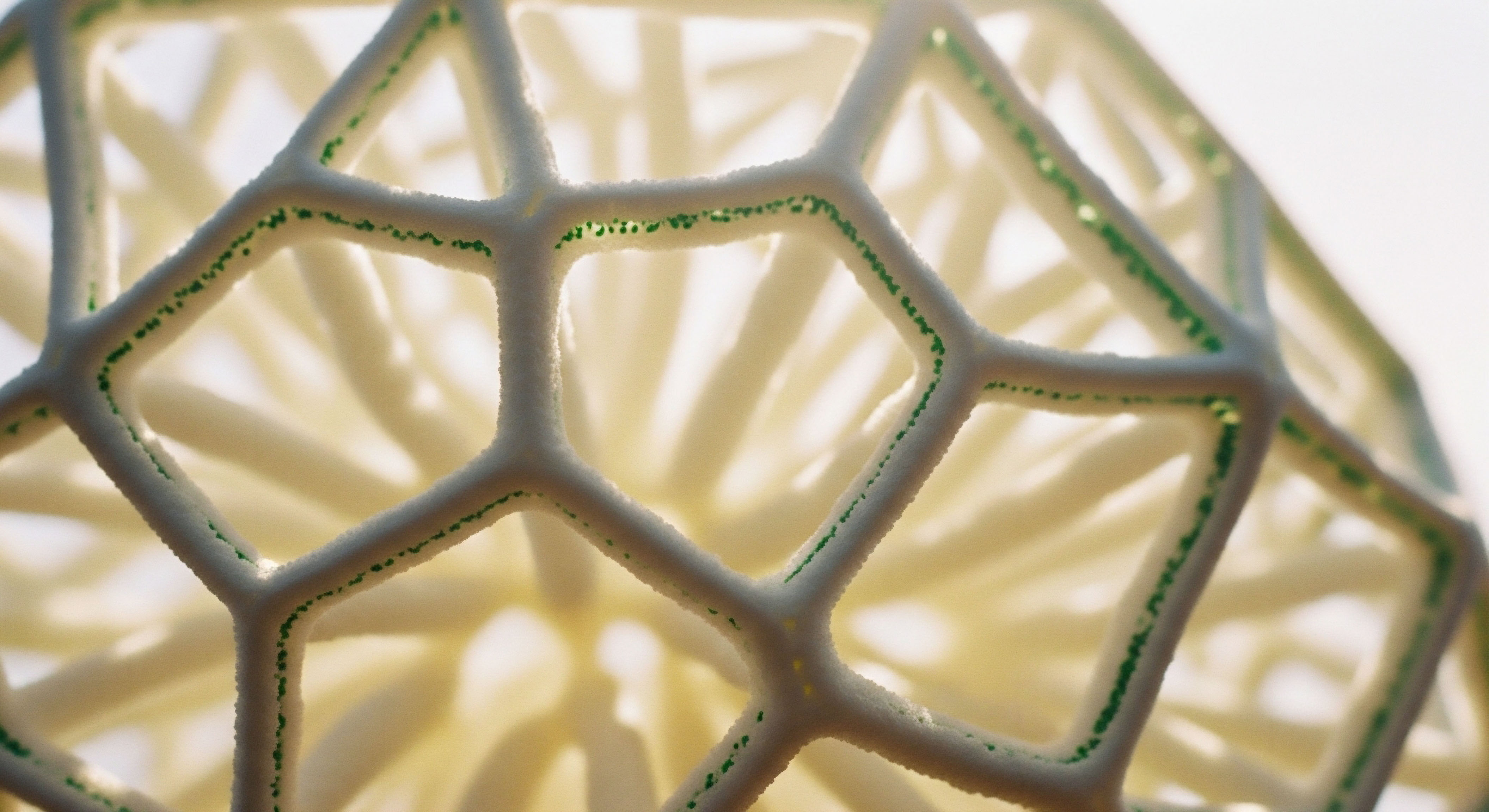

Fundamentals
You may have noticed a subtle shift in your cognitive landscape. Words that were once readily available now seem just out of reach. The sharpness of your focus feels blunted, and the mental energy required to manage a complex day feels significantly greater than it once did.
This experience, often dismissed as an inevitable consequence of aging, is a deeply personal and valid observation of a biological process. It is the lived experience of changes occurring at a cellular level within your brain. Understanding these changes is the first step toward actively influencing them.
Your body communicates through an intricate network of signaling molecules, a biological language that dictates function from moment to moment. Hormones are the primary messengers in this system, and Growth Hormone (GH) is a principal conductor of this orchestra, particularly concerning cellular regeneration and vitality.
Growth Hormone’s role extends far beyond the adolescent growth spurts it is named for. In the adult body, it becomes a master regulator of tissue repair, metabolic efficiency, and cellular turnover. It is the signal that instructs your body to mend and maintain itself. As we age, the production and release of GH declines.
This process, known as somatopause, is a key driver of many age-associated changes, including the cognitive shifts you may be experiencing. The brain, a highly metabolic and active organ, is particularly sensitive to this decline. Its ability to repair neurons, form new connections, and protect itself from inflammation is directly tied to the strength of this hormonal signal.
When the signal weakens, the brain’s capacity for self-maintenance diminishes, leading to symptoms like brain fog, memory lapses, and a general feeling of reduced cognitive horsepower.
Peptide therapies work by providing precise, targeted signals to rejuvenate the body’s own cellular repair and communication systems.
This is where the science of specific peptides becomes relevant to your personal health journey. Peptides are small, elegant chains of amino acids, the very building blocks of proteins. They function as highly specific keys, designed to fit particular locks, or receptors, on the surface of your cells.
Growth hormone-releasing peptides, or secretagogues, are a class of these molecules that possess a unique ability. They are designed to interact directly with the pituitary gland, the body’s own control center for GH production. Their function is to restore the youthful, pulsatile release of your own growth hormone.
This approach provides a bio-identical signal, gently prompting your body to recalibrate its own systems. It is a strategy of restoration, aiming to bring the body’s internal communication network back to a state of optimal function.

The Language of Cellular Communication
To appreciate how these peptides function, one must first understand the system they influence. The brain is in a constant state of dynamic activity. Neurons fire, connections are pruned, and new pathways are formed. This entire process is governed by a delicate balance of growth signals and inflammatory responses.
Think of it as a meticulously maintained garden. Growth factors act as the nutrients and water, encouraging new growth and strengthening existing plants. Inflammatory molecules are like weeds and pests, which, if left unchecked, can overwhelm the garden and stifle its vitality.
As GH levels decline with age, the “nutrients” become scarcer, and the “weeds” of inflammation find it easier to take hold. This imbalance contributes directly to the neurodegenerative processes that underlie cognitive decline. Peptides that stimulate GH release effectively replenish the supply of these vital growth signals, helping to restore balance to the brain’s ecosystem.

What Are Peptides?
Peptides are short chains of amino acids linked by peptide bonds. Their small size and specific structure allow them to act as precise signaling molecules, instructing cells to perform particular tasks.
- Specificity Peptides are designed to bind to specific cellular receptors, minimizing off-target effects and ensuring their message is delivered to the correct cells.
- Bio-identical Signaling Many therapeutic peptides mimic the body’s own natural signaling molecules, allowing them to integrate seamlessly into biological pathways.
- Restorative Function The primary goal of many peptide protocols is to restore the body’s own production of essential hormones and growth factors, rather than simply replacing them with a synthetic version.
By understanding that the symptoms of cognitive aging are rooted in tangible, biological changes, you can begin to see a path forward. The conversation shifts from one of passive acceptance to one of proactive management.
The science of peptide therapy offers a sophisticated toolkit for engaging with the body’s own regenerative systems, providing a means to support brain health and cognitive function from the cellular level up. This journey is about reclaiming your biological vitality and ensuring your brain has the resources it needs to function at its peak.


Intermediate
The journey from recognizing cognitive changes to understanding their hormonal underpinnings brings us to a more detailed examination of the mechanisms at play. The body’s endocrine system is a finely tuned apparatus, and the regulation of Growth Hormone (GH) is a prime example of its complexity.
This regulation is primarily managed by the Hypothalamic-Pituitary (HP) axis. The hypothalamus, a small region at the base of the brain, acts as the master controller. It produces Growth Hormone-Releasing Hormone (GHRH), which signals the pituitary gland to synthesize and release GH.
The pituitary then releases GH into the bloodstream in distinct pulses, primarily during deep sleep and after intense exercise. This pulsatile release is a critical feature of healthy endocrine function. It is this natural rhythm that specific peptides seek to restore.
As the body ages, two significant changes occur within this system. First, the hypothalamus produces less GHRH. Second, another hormone, somatostatin, which inhibits GH release, often becomes more dominant. The combination of a weaker “go” signal and a stronger “stop” signal leads to a dramatic reduction in both the frequency and amplitude of GH pulses.
This is the biological reality of somatopause. The consequence is a systemic decline in the regenerative signals that GH and its primary mediator, Insulin-like Growth Factor 1 (IGF-1), provide to all tissues, including the brain. IGF-1, produced mainly in the liver in response to GH, is a potent neuroprotective agent that promotes the growth, survival, and differentiation of neurons.
When GH pulses flatten, IGF-1 levels drop, leaving the brain more vulnerable to age-related damage and reducing its capacity for repair.

How Do Peptides Restore Youthful Hormone Patterns?
Growth hormone secretagogue peptides work by intervening in this process at specific points. They are not a blunt instrument that floods the system with synthetic hormones. They are sophisticated modulators that encourage the body’s own machinery to function more efficiently. Different peptides have different mechanisms of action, allowing for a tailored approach to restoring GH pulsatility.
- GHRH Analogs Peptides like Sermorelin are analogs of our natural GHRH. They bind to the GHRH receptor on the pituitary gland, mimicking the body’s own “go” signal. This prompts the pituitary to produce and release its stored GH in a manner that respects the body’s natural feedback loops.
- Ghrelin Mimetics (GHS-R Agonists) Peptides like Ipamorelin and Hexarelin work through a different but complementary pathway.
They mimic a hormone called ghrelin, which binds to the growth hormone secretagogue receptor (GHS-R) in the pituitary. This action also stimulates GH release, and when combined with a GHRH analog, the effect is synergistic, leading to a more robust and natural GH pulse.
- Combined Formulations The combination of a GHRH analog with a ghrelin mimetic, such as the widely used CJC-1295 and Ipamorelin protocol, represents a powerful strategy.
CJC-1295 provides a steady, low-level stimulation of the GHRH receptor, creating a “permissive” environment for GH release. Ipamorelin then provides the acute, pulsatile signal. This dual-action approach more closely mimics the body’s natural rhythms, leading to a significant restoration of GH levels and, consequently, IGF-1 production.
The strategic combination of different peptide classes can restore the natural, pulsatile release of growth hormone, which is essential for brain health and repair.
This restoration of a youthful GH/IGF-1 axis has profound implications for brain health. Enhanced IGF-1 signaling in the brain activates pathways that support neurogenesis, the creation of new neurons, particularly in the hippocampus, a region critical for learning and memory.
It also promotes synaptogenesis, the formation of new connections between neurons, which is the physical basis of learning. Furthermore, both GH and IGF-1 have potent anti-inflammatory effects within the brain, helping to quell the chronic, low-grade inflammation that is a hallmark of neurodegenerative processes. They also support the health of the brain’s vascular system, ensuring that brain cells receive the oxygen and nutrients they need to function optimally.

Comparing Common Growth Hormone Peptides
Understanding the distinct properties of each peptide allows for the development of personalized protocols that align with an individual’s specific health goals and biological needs. The choice of peptide is based on its mechanism, duration of action, and desired clinical outcome.
| Peptide | Mechanism of Action | Primary Clinical Application |
|---|---|---|
| Sermorelin | GHRH Analog | General anti-aging, restoration of youthful GH pulse. |
| CJC-1295 | Long-acting GHRH Analog | Sustained elevation of GH/IGF-1 levels, often used for body composition. |
| Ipamorelin | Selective Ghrelin Mimetic (GHS-R Agonist) | Pulsatile GH release with minimal impact on cortisol or prolactin. |
| Tesamorelin | Stabilized GHRH Analog | Specifically studied for reducing visceral adipose tissue. |
The clinical application of these peptides is a process of biochemical recalibration. By re-establishing the body’s natural signaling patterns, these therapies support the brain’s intrinsic ability to repair itself. This is a functional approach to medicine, one that seeks to optimize the body’s own systems rather than merely overriding them.
The result is a cascade of positive effects, from improved synaptic plasticity and neuronal survival to reduced inflammation and enhanced cognitive function. It is a scientifically grounded strategy for nurturing the brain and preserving its vitality over the long term.


Academic
A granular analysis of the influence of growth hormone secretagogues on brain health requires a shift in perspective from systemic effects to the molecular machinery of the neuron itself. The neuroprotective and neuro-regenerative properties of the GH/IGF-1 axis are not abstract concepts; they are the direct result of the activation of specific intracellular signaling cascades that govern cell fate.
When a GHRH analog like Tesamorelin or a ghrelin mimetic like Ipamorelin initiates a GH pulse, the subsequent rise in both GH and IGF-1 triggers a series of phosphorylation events within neurons and glial cells, fundamentally altering their function and resilience. These peptides are, in essence, initiators of a complex biological program dedicated to cellular repair and plasticity.
One of the most significant pathways implicated in the neurotrophic effects of the GH/IGF-1 axis is the Phosphoinositide 3-kinase (PI3K)/Akt pathway. IGF-1 binding to its receptor (IGF-1R) on a neuron’s surface leads to the receptor’s autophosphorylation and subsequent recruitment of insulin receptor substrate (IRS) proteins.
This complex then activates PI3K, which in turn phosphorylates and activates Akt, a serine/threonine kinase. Activated Akt is a central node in cell signaling, promoting cell survival through multiple downstream mechanisms. It phosphorylates and inactivates pro-apoptotic proteins like BAD and caspase-9, directly inhibiting the cellular machinery of programmed cell death. This anti-apoptotic effect is a cornerstone of neuroprotection, helping to preserve neuronal populations in the face of metabolic stress, excitotoxicity, or inflammatory insults.

What Are the Molecular Pathways Activated by GHRH Analogs?
The therapeutic potential of GHRH analogs in conditions of neural injury, such as ischemic stroke, is supported by robust preclinical data. Studies utilizing potent, stabilized GHRH agonists have demonstrated a significant enhancement of endogenous neuro-restorative processes. The mechanism extends beyond simple cell survival.
Activated Akt also phosphorylates and activates the transcription factor CREB (cAMP response element-binding protein). CREB is a master regulator of gene expression related to neuronal plasticity, learning, and memory. Once activated, CREB translocates to the nucleus and promotes the transcription of key neurotrophic factors, most notably Brain-Derived Neurotrophic Factor (BDNF).
This induction of BDNF expression creates a powerful positive feedback loop. BDNF, in turn, binds to its own receptor, Tropomyosin receptor kinase B (TrkB), activating parallel and synergistic signaling cascades, including the same PI3K/Akt pathway as well as the Ras/MAPK pathway.
This BDNF/TrkB signaling is fundamental for synaptogenesis, the growth of dendritic spines, and the long-term potentiation (LTP) that underlies memory formation. Therefore, the initial signal from a peptide-induced GH pulse is amplified within the brain into a sustained program of structural and functional adaptation.
Research has shown that treatment with GHRH analogs can significantly improve neurogenesis and neuroplasticity in areas of ischemic damage, directly linking the peptide’s action to the activation of the Akt/CREB and BDNF/TrkB pathways.
Peptide-induced growth hormone release activates the Akt/CREB and BDNF/TrkB signaling cascades, which are fundamental for neuronal survival, neurogenesis, and synaptic plasticity.
The process of adult neurogenesis, particularly within the dentate gyrus of the hippocampus, is profoundly influenced by GH and IGF-1. This region is one of the few areas in the adult mammalian brain that retains a population of neural stem cells (NSCs).
GH and IGF-1 act as potent mitogens for these NSCs, promoting their proliferation and differentiation into new neurons. Studies using markers for cell proliferation (BrdU) and immature neurons (Doublecortin, DCX) have shown that GH administration significantly increases the number of new neurons in the dentate gyrus.
This enhanced neurogenesis provides a pool of new neurons that can integrate into existing hippocampal circuits, contributing to improved cognitive function, particularly in spatial learning and memory consolidation. The ability of GH secretagogue peptides to restore the physiological signaling required for this process is a key mechanism behind their pro-cognitive effects.

Cellular Actions of GH Peptides on Brain Tissue
The influence of these peptides extends to the various cell types that constitute the brain’s complex architecture. The coordinated response of these cells is what translates a hormonal signal into a functional outcome like improved memory or recovery from injury.
| Cell Type | Effect of GH/IGF-1 Axis Stimulation | Governing Molecular Pathway |
|---|---|---|
| Neurons | Enhanced survival, synaptogenesis, dendritic branching. | PI3K/Akt, BDNF/TrkB, MAPK/ERK |
| Neural Stem Cells | Increased proliferation and differentiation. | Notch, Wnt, PI3K/Akt |
| Oligodendrocytes | Promotion of myelination and repair of white matter tracts. | PI3K/Akt/mTOR |
| Microglia | Modulation from pro-inflammatory to anti-inflammatory phenotype. | SOCS, STAT3 |
Furthermore, the role of GH in modulating neuroinflammation is of critical importance. Microglia, the brain’s resident immune cells, can exist in different activation states. In a pro-inflammatory state, they release cytokines that can be damaging to neurons. In an anti-inflammatory state, they promote debris clearance and tissue repair.
Both GH and IGF-1 have been shown to shift microglia towards this beneficial, anti-inflammatory phenotype. This action helps to create a more permissive environment for neuronal survival and regeneration. By quieting the background noise of chronic inflammation, peptide therapies allow the brain’s own repair mechanisms to function more effectively.
This multifaceted influence, spanning direct neuronal support, stimulation of neurogenesis, and modulation of the immune environment, illustrates the profound and systemic impact that restoring GH pulsatility can have on the cellular health of the brain.

References
- Cai, Y. et al. “Agonistic analog of growth hormone ∞ releasing hormone promotes neurofunctional recovery and neural regeneration in ischemic stroke.” Proceedings of the National Academy of Sciences, vol. 111, no. 41, 2014, pp. 14831-14836.
- Blackman, M. R. et al. “Growth Hormone and Sex Steroid Administration in Healthy Aged Women and Men.” JAMA, vol. 288, no. 18, 2002, pp. 2282-2292.
- Åberg, M. A. et al. “Peripheral infusion of IGF-I selectively induces neurogenesis in the adult rat hippocampus.” The Journal of Neuroscience, vol. 20, no. 8, 2000, pp. 2896-2903.
- Devesa, J. et al. “Treatment with Growth Hormone (GH) Increased the Metabolic Activity of the Brain in an Elder Patient, Not GH-Deficient, Who Suffered Mild Cognitive Alterations and Had an ApoE 4/3 Genotype.” Cells, vol. 9, no. 1, 2019, p. 74.
- Christie, K. J. and Turnley, A. M. “The multiple roles of GH in neural ageing and injury.” Growth Hormone & IGF Research, vol. 69, 2023, p. 101538.
- Pathipati, P. et al. “Recombinant human growth hormone (r-hGH) and its secretagogue (r-hGHS) stimulate the proliferation of neural and cardiac stem cells.” Journal of Neurorestoratology, vol. 2013, no. 1, 2013, pp. 13-22.
- Azcoitia, I. et al. “Growth hormone prevents neuronal loss in the aged rat hippocampus.” Neurobiology of Aging, vol. 26, no. 5, 2005, pp. 697-703.
- Leal-Cerro, A. et al. “The growth hormone-releasing peptide-2 (GHRP-2) test for the diagnosis of growth hormone (GH) deficiency in adults.” The Journal of Clinical Endocrinology & Metabolism, vol. 83, no. 8, 1998, pp. 2750-2754.

Reflection
The information presented here offers a detailed map of the biological systems that influence your cognitive health. You have seen how a decline in a specific hormonal signal, Growth Hormone, can manifest as the brain fog and memory lapses you may be experiencing.
You have also seen the elegant science behind peptide therapies, which are designed to restore the body’s own regenerative capacity. This knowledge is a powerful tool. It transforms the narrative from one of inevitable decline to one of proactive, informed self-stewardship.
The path to sustained vitality is a personal one, built upon an understanding of your unique biology. Consider this exploration the beginning of a new conversation with your body, one where you are equipped with the language to listen to its signals and the knowledge to provide what it needs to heal and function optimally. What will your next step be on this path to reclaiming your cognitive vitality?

Glossary

growth hormone

somatopause

pulsatile release

cognitive function

brain health

igf-1

growth hormone secretagogue

ghrh analogs

sermorelin

ghrh analog

ipamorelin

ghrelin mimetic

cjc-1295

neurogenesis

igf-1 axis

synaptogenesis

neuroprotection

brain-derived neurotrophic factor

bdnf




